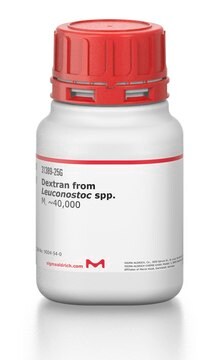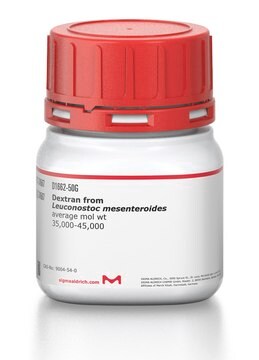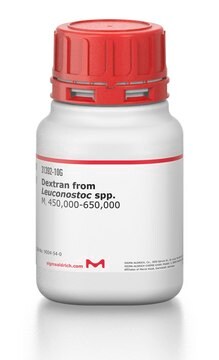D8821
Dextran from Leuconostoc mesenteroides
average mol wt 60,000-76,000
About This Item
Prodotti consigliati
Origine biologica
bacterial (Leuconostoc mesenteroides)
Livello qualitativo
Stato
powder
Attività ottica
[α]20/D 190 to 201 °, c = 2% (w/v) in water
PM
average mol wt 60,000-76,000
Colore
white to off-white
Punto di fusione
483 °C ((901 °F ))
Solubilità
water: 100 mg/mL at 25 °C, colorless to faintly yellow
Temperatura di conservazione
2-8°C
InChI
1S/C18H32O16/c19-1-5(21)9(23)10(24)6(22)3-31-17-16(30)14(28)12(26)8(34-17)4-32-18-15(29)13(27)11(25)7(2-20)33-18/h1,5-18,20-30H,2-4H2
FZWBNHMXJMCXLU-UHFFFAOYSA-N
Cerchi prodotti simili? Visita Guida al confronto tra prodotti
Categorie correlate
Descrizione generale
Applicazioni
- in resuspension of pellets and in Hanks′ balanced salt solution (HBSS) for the isolation of vascular nuclei from frozen post-mortem brain tissue
- to prepare dextran solution in phosphate buffer saline and to maintain corneal hydration and restore corneal thickness to physiological levels of human eyes
- as a polymer solution in the in situ aqueous two-phase systems (ATPS) formation with lysozyme PEGylation reaction
Azioni biochim/fisiol
Altre note
Codice della classe di stoccaggio
11 - Combustible Solids
Classe di pericolosità dell'acqua (WGK)
WGK 2
Scegli una delle versioni più recenti:
Possiedi già questo prodotto?
I documenti relativi ai prodotti acquistati recentemente sono disponibili nell’Archivio dei documenti.
I clienti hanno visto anche
Il team dei nostri ricercatori vanta grande esperienza in tutte le aree della ricerca quali Life Science, scienza dei materiali, sintesi chimica, cromatografia, discipline analitiche, ecc..
Contatta l'Assistenza Tecnica.



